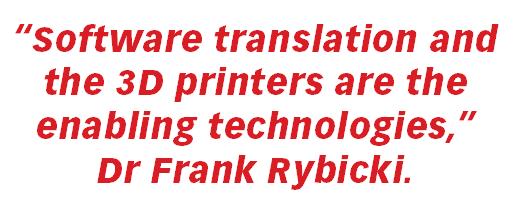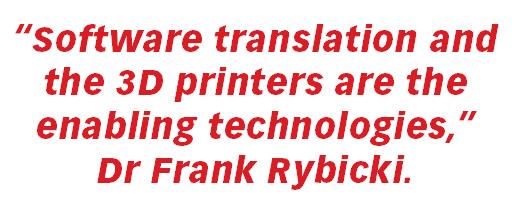While not directly design engineering, this application demonstrates an innovative use of some tools more normally associated with the design and prototyping environment. And these techniques could bear relevance in the future, perhaps when technology, medicine and cosmetics have converged further.
This procedure was developed by physicians at Brigham and Women's Hospital in Boston. They performed the country's first full-face transplant in 2011 and have subsequently completed four additional face transplants. The procedure is performed on patients who have lost some or all of their face as a result of injury or disease.
"This is a complex surgery and its success is dependent on surgical planning," said Dr Frank Rybicki, one of the pioneers of this technology application. "Our study demonstrated that if you use this model and hold the skull in your hand, there is no better way to plan the procedure. The idea is to make a high-fidelity model of patients' skull before surgery so that surgeons have a better idea about the pathology."
 The study was recently presented to the Radiological Society of North America (RSNA). The team was made up of radiologist and director of the Boston hospital's Applied Imaging Science Laboratory Dr Rybicki, Dr Bohdan Pomahac the lead face transplantation surgeon, and research fellow Dr Amir Imanzadeh. They assessed the clinical impact of using 3D printed models of the recipient's head in the planning of face transplantation surgery.
The study was recently presented to the Radiological Society of North America (RSNA). The team was made up of radiologist and director of the Boston hospital's Applied Imaging Science Laboratory Dr Rybicki, Dr Bohdan Pomahac the lead face transplantation surgeon, and research fellow Dr Amir Imanzadeh. They assessed the clinical impact of using 3D printed models of the recipient's head in the planning of face transplantation surgery.
Each of the transplant recipients underwent preoperative CT with 3D visualisation. To build each life-size skull model, the CT images of the transplant recipient's head were segmented and processed using customised software, creating specialised files that were input into a 3D printer.
"You can spin, rotate and scroll through as many CT images as you want but there's no substitute for having the real thing in your hand," Dr Rybicki said. "The ability to work with the physical model gives you an unprecedented level of reassurance and confidence in the procedure."
"In some patients, we need to modify the recipient's facial bones prior to transplantation," Dr Imanzadeh said. "The 3D printed model helps us to prepare the facial structures so when the actual transplantation occurs, the surgery goes more smoothly."
The material can vary for each model, however the majority of models are made from photopolymers and resins.
Dr Rybicki commented: "Selection of material is dependent on a couple of factors including the technology of 3D printing. Some methods use metals, others use plastics, the cost, and the purpose of use i.e. implants vs surgical guides."
For means of medical 3D printing, three sets of software are required: software for determination of organs and structures from radiology images (segmentation software); software to refine the STL output from the first software package (CAD software); and software that can transfer final output from CAD software to a printer (printer driver/software). All of them are in common use and are designed and produced by commercial companies. The radiologists, who are behind this application, have nothing to do with that aspect.
The enabling technologies for this application are, according to Dr Rybicki: "Software translation and the printer - the scans have not changed. CT is used more because it is cheaper, more frequently used, and the segmentation of CT images are easier than MRI. However, if necessary MRI datasets can be utilised. Even ultrasound and 3D angiography images can be used as the source for means of 3D printing."
CT, or CAT, stands for computerised axial tomography. It uses x-ray technology but the images created, the tomograms, are more detailed than standard x-rays. Another advantage from the patient's perspective is that CT scans last five to ten minutes, while an MRI scan can take over an hour and involve being inside a tunnel, which some can find claustrophobic.
The quality of the models is of paramount importance and a couple of 3D printing systems have been used to attain this quality, the SLA 7000 by 3D systems and the Connex 5500 by Stratasys.
The SLA 7000 is the fastest printer in the 3D Systems range by a factor of two. It uses stereolithography technology to build up models with layers as thin as 0.025mm to provide a smooth finish and reduce the amount of post-processing required. The Connex printers use Stratasys' polyjet technology and the material is cured by UV light rather than by laser. These machines can achieve a resolution in terms of layer thickness of 0.016mm and can produce models made of more than one material.
Printing was not done internally, but as part of a U.S. Department of Defence contract and research collaboration with Walter Reed Medical Center, which was understandable given the low volumes involved and the high cost of the 3D printers. Each project therefore has its own price. "Generally speaking a model can cost from roughly $70 up to $2000, based on the material, size, etc.," said Dr Rybicki. "The average cost for our models was $500."

The entire transplant procedure lasts as long as 25 hours, and any time saved is precious for surgical, aesthetic and business reasons. This technique of printing the head has typically saved anywhere from ten minutes to more than an hour depending on the procedure. Dr Rybicki commented on the benefits: "Some of the studies demonstrated that surgeons who used models for pre-surgical planning, managed to decrease patients' blood loss during the operation significantly. Savings of even one minute of operating theatre time is very important, not only because it decreases the duration of anaesthesia, but also it saves considerable amount of money for the hospital."
And the use of models improves both medical and aesthetic outcomes, as Dr Rybicki explained: "For instance, using models in transplants (kidney, liver, etc.) reduces the total operation time as well as morbidity and mortality of the patients. And with the help of 3D printing, parts/prostheses, for example an ear that is very similar to patient's normal structures, can be fabricated, which improves the aesthetic outcome."
Despite the progress being initially made in face transplants, 3D models can be used in almost any type of surgeries for either pre-surgical planning or intra-operation navigation. For example, a spine surgeon can take 3D printed vertebrae models of a patient with scoliosis to the operating theatre and use them to find out the orientation of the vertebrae in the body.
Maybe this is a sphere where the skills of the design engineer in producing 3D printable designs will dovetail with the medical profession to develop this new discipline.

